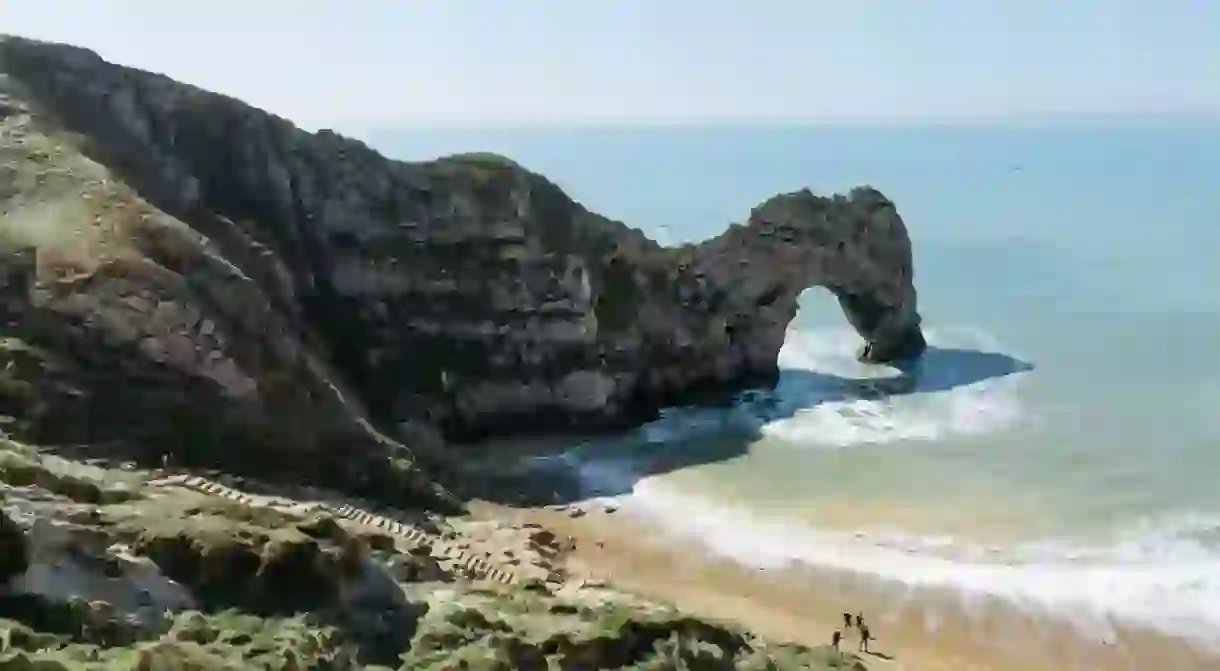7 Beautiful Stops to Make Along England’s Jurassic Coast

England’s Jurassic Coast is one of the finest stretches of coastline in Europe, connecting the picturesque port town of Exmouth, East Devon, to the seaside resort of Studland Bay, Dorset. Between these two counties are a series of breathtaking beaches, coastal villages and natural rock formations well worth visiting.
Durdle Door
Behold the wonders of Durdle Door! Those familiar with England’s south-west coastline will have undoubtedly seen a photograph of this iconic landmark at some point; we’re pleased to say it doesn’t disappoint in person.
Grandiose in structure and arguably the most famous stone arch in the world, Durdle Door is a natural limestone arch which gets its look thanks to the Dorset coast’s powerful waves that, around 140 million years ago, eroded the rocks and drilled a hole through the middle. Durdle Door, which gets its name from the old English word ‘thirl’, which means to ‘pierce’ or ‘drill’, was designated England’s first UNESCO World Heritage Site back in 2001, along with the rest of the Jurassic Coast, and sits in the prestigious company of the Grand Canyon, Machu Picchu and Venice. Steps leading down to Durdle Door’s beach can be quite rocky, so it’s wise to bring suitable footwear and take your time!




Man O’War Beach
For unrivalled views of this part of the stunning Jurassic Coast, head just east of Durdle Door to Man O’War Beach. It’s here where you’ll find some of the clearest waters this side of the Atlantic, with views for miles across the coast and limestone rocks. For the more adventurous visitors, why not indulge in an official Jurassic Coast kayak tour?
Due to erosion, the recommended route down to the beach is currently closed, so we do not recommend attempting to scale the steps. However, Man O’War Beach is still worth a stop-off thanks to its idyllic scenery and proximity to Durdle Door.




South West Coast Path
The South West Coast Path is the longest walking route in Britain, racking in an impressive 630 miles (1,013 kilometres) of gorgeous south-west coastline to explore! Taking in the entire 95 miles (152 kilometres) of the Jurassic Coast, keen ramblers and hikers can follow a number of official walking routes along the path with just the fresh sea air and changing landscape for company.
Experienced walkers could take the full 95-mile route across multiple days, but for a gentle amble, we’d recommend one of the shorter routes between 5–15 miles (8–24 kilometres). Whichever trail you decide to take, exploring the 185 million years of geological history is an incredible experience!





Lulworth Cove
Another of the must-do stops on the Jurassic Coast is Lulworth Cove, with its white pebbled beaches, easy access and turquoise waters making it a popular choice for families in the summer months. Renowned as one of the best landforms in the world, Lulworth Cove sees over half a million tourists flock to its coastal curve all year round, sampling some of the best views the country has to offer.
Lulworth Cove can get particularly busy during peak times (May–September), but the boat trips, available throughout summer, are worth the visit alone. Feeling lavish? Bishops B&B is a four-star boutique hotel with an outdoor pool that overlooks the Cove (pictured below, top left). Go on, treat yourselves.





Kimmeridge Bay
Explorers and adventurers, continue reading! Kimmeridge Bay might just be for you. Housed within the Purbeck Marine Wildlife Reserve, this popular bay is Dorset’s best site for activities such as rock pooling and snorkelling! Kimmeridge Bay’s stretches of black clay are thought to record marine life as far back as 150 million years and are still a source of natural oil to this day. The keen-eyed out there will spot the ‘nodding donkey’ on the opposite side of the bay, which is actually an active oil well.
Much prefer the calmer side of life? Make your way up to the impressive Clavell Tower for fantastic views of the bay and beyond.



Seatown
Quintessentially English, Seatown is a coastal hamlet town just one mile (1.6 kilometres) from Golden Cap, the highest point on England’s south coast. Visitors to Seatown will find a mixed pebble/shingle beach backed with steep cliff edges, a quaint pub and some fantastic fossils, as the eroding cliffs yield a plentiful supply over the winter months. When you’re all done fossil hunting, we’d suggest a walk up Langdon Hill to admire the view ahead of you.
Please note: Fossil hunters are allowed to collect any that are loose but are not permitted to hammer directly into the cliff or foreshore.



Stair Hole
Last but not least is Stair Hole, one of the most impressive natural rock formations in the country. The finest example of coastal erosion along the Exmouth-Dorset coastline, Stair Hole showcases natural caves, arches, blowholes and more. Visitors should also note Lulworth Crumple to the side, which shows once sedimentary twisted and tilted rocks, known as limestone folding, caused by tectonic plate movement millions of years ago.
Stair Hole suggests what Lulworth Cove would have looked like several hundred thousands of years ago, though it is now thought to be eroding incredibly fast!
















